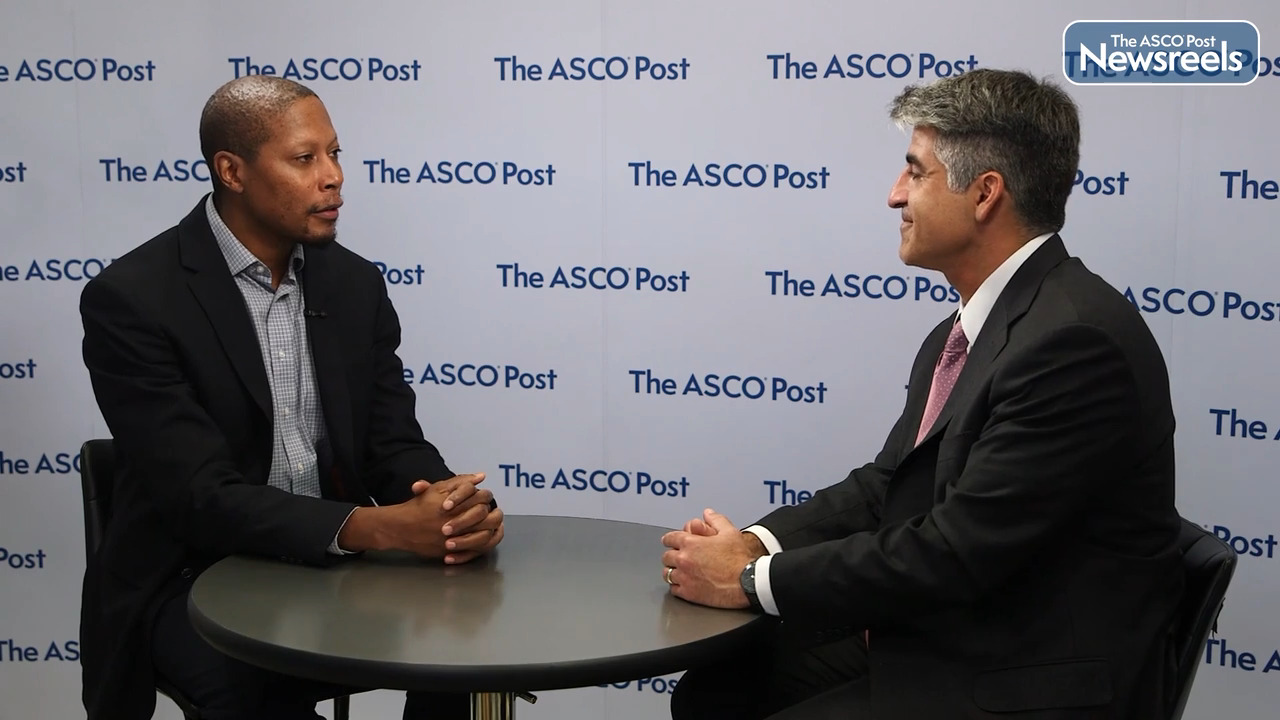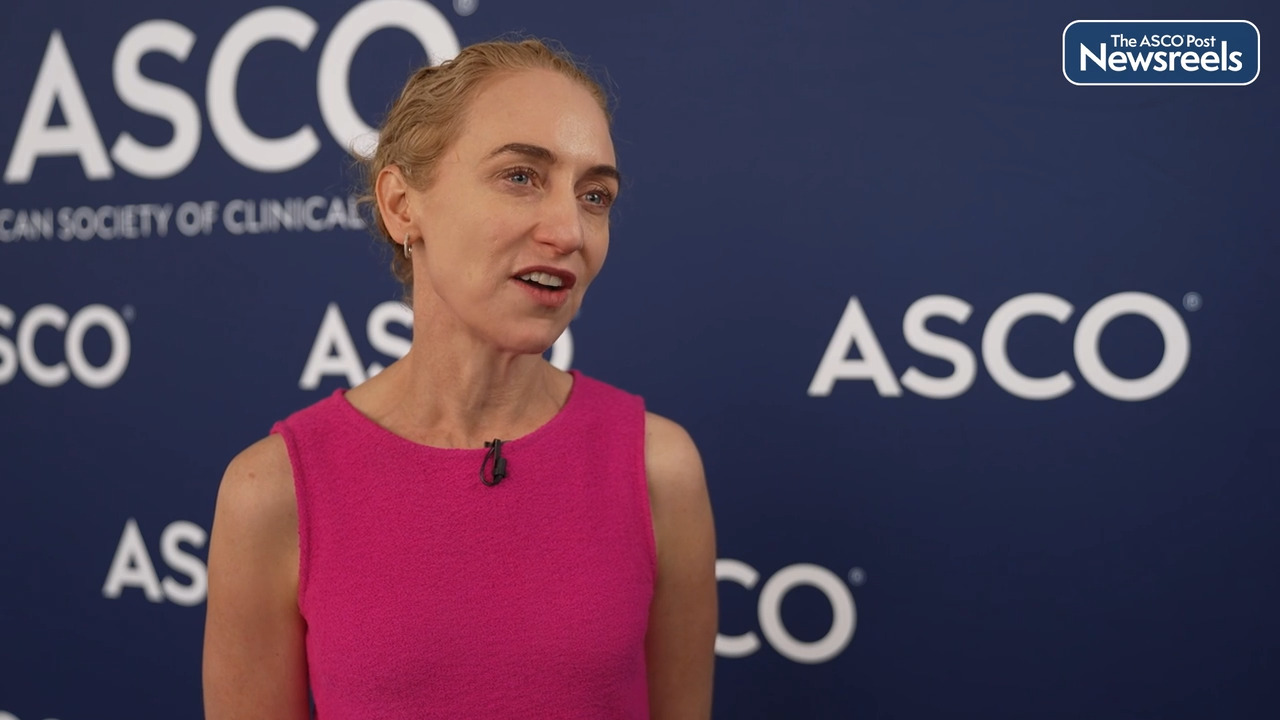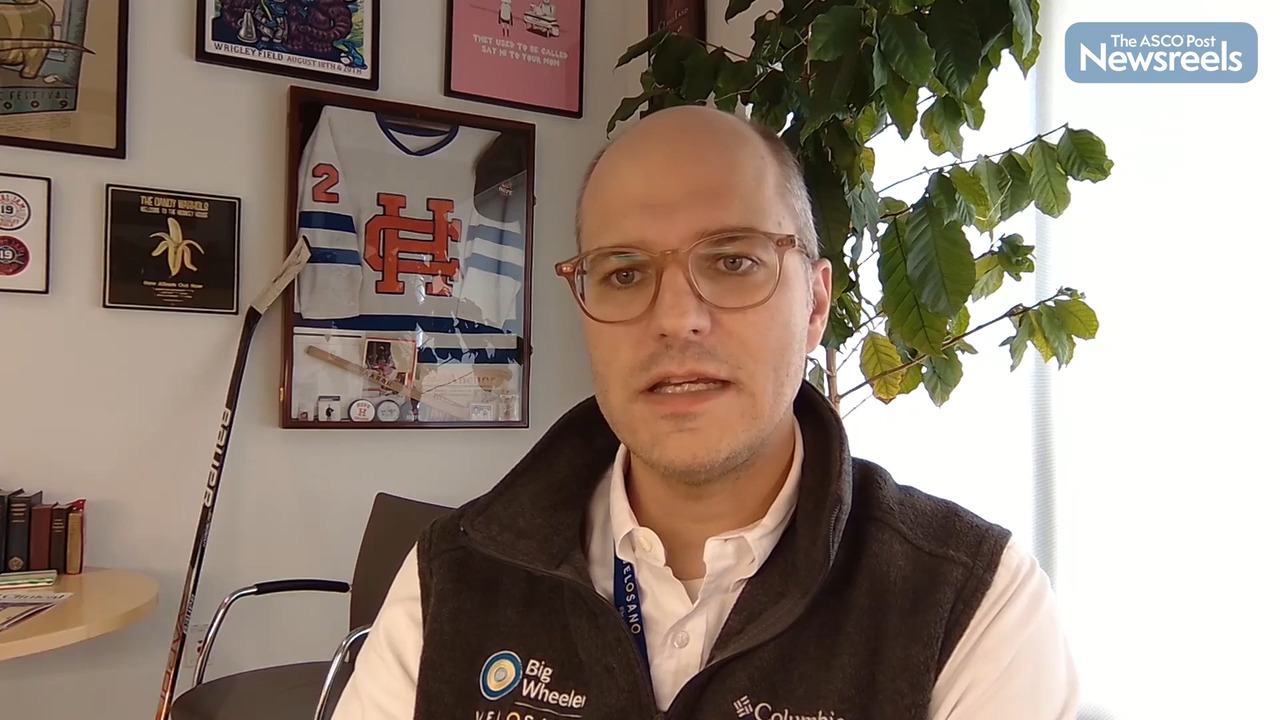Transcript
Disclaimer: This video transcript has not been proofread or edited and may contain errors.
Smitha Krishnamurthi:
Well Deb, it's wonderful to have you here to talk about your prospect trial, which was just presented at the plenary. So we've all been anxiously awaiting that study and it was just such a thrill to hear the results. So thrilled you could be here. And would you mind walking us through what was the motivation you had in starting that study?
Deb Schrag:
Yeah, so this trial I think has a great story of how we came to do it, what the idea was. And there are really two key sources. And the first is that as in 2002 we first got FOLFOX and around the same time we also got FOLFIRI. So we started treating patients with colorectal cancer, metastatic colorectal cancer with more lines of treatment and more intensive treatment. And we noticed something really interesting, and I love how it all goes back to the clinic and it all goes back to observations that we make in the course of treating patients.
Smitha Krishnamurthi:
I thought there may be this angle to it.
Deb Schrag:
Absolutely. So what we found was that patients who had a history of rectal cancer that had been radiated. When they developed metastatic disease and we gave them a dose of FOLFOX or FOLFIRI, their counts were more likely to plummet.
Smitha Krishnamurthi:
Exactly.
Deb Schrag:
Because of the pelvic radiation, the marrow reserve was impaired. So we realized yet another late effect of radiation is less tolerance for chemotherapy. So that was the first motivator. The second motivator was the epidemic of early onset colorectal cancer and seeing so many young patients presenting-
Smitha Krishnamurthi:
And were noticing this early on into this epidemic.
Deb Schrag:
We were noticing this early on and we had patients and I know you've had those same patients for whom fertility preservation is critical or the potential to enter early menopause is just not acceptable. And since we had really good experience treating Stage 4 rectal cancer with induction FOLFOX and seeing really dramatic brisk quick responses, we wondered could we do this in the adjuvant setting and then perhaps back off on the radiation
Smitha Krishnamurthi:
In the neoadjuvant setting?
Deb Schrag:
In the neoadjuvant setting.
Smitha Krishnamurthi:
Yeah.
Deb Schrag:
Absolutely.
Smitha Krishnamurthi:
Absolutely.
Deb Schrag:
In the neoadjuvant setting. Now, this was not a study for high rectal cancers. We already know in high rectal cancers that we can usually start with surgery and treat based on the postoperative findings. We really were focusing on the mid rectal cancers.
Smitha Krishnamurthi:
And this was at the time when we were all doing chemo, radiation, surgery, adjuvant therapy. So this was-
Deb Schrag:
Yes, so we started prospect before the TNT era. So it was the era when the standard of care was six weeks of chemo, radiation, recovery surgery. And it was typically eight cycles of FOLFOX, although it sort of migrated to... It cycles FOLFOX or some CAPOX. And I think with the idea in 2017, people started to back off a little bit.
Smitha Krishnamurthi:
Yeah. So this was a monumental effort. Kudos to you enrolling over 1,100 patients over six years and I was a site principal investigator and you remember, [inaudible 00:03:38] both-
Deb Schrag:
I remember talking to you.
Smitha Krishnamurthi:
... remember this. I couldn't believe it that the National PI was calling me now to get the study going. And it really struck me how personally invested you were, how much time you must be putting into this. And it's just so delightful to see you get this important study over the finish line.
Deb Schrag:
Thank you. Yeah, it was a lot of work. I think what I'm proud of is that we really had engagement. I think we had 264 sites.
Smitha Krishnamurthi:
Amazing.
Deb Schrag:
And as you know, as well as I, rectal cancer is really a team effort.
Smitha Krishnamurthi:
For sure.
Deb Schrag:
We had engagement of radiation, medical oncologists and surgeons. Surgical oncologists, colorectal surgeons, pathologists. A key person on the team was our imager because we know that pelvic MRI is such a critical component of rectal cancer staging. In fact, without rectal MRI, our ability to select patients for this trial would've been impossible.
Smitha Krishnamurthi:
Yeah. And I noticed about 85% I think had the MRI, but probably you wanted to be inclusive and allow as many people to enroll.
Deb Schrag:
Right. At the time we designed the trial, there were some patients who had barriers and could not obtain an MRI. So we were inclusive and the alternative was a contrast enhanced CAT scan and endorectal ultrasound. So those patients were very well staged and imaged as well.
Smitha Krishnamurthi:
Awesome. So in this study, patients were enrolled to FOLFOX and had a 20% reduction after the six cycles, would then go on to TME if they were on that arm. Otherwise they'd have the selective chemo RT. So how was that 20% reduction determined?
Deb Schrag:
Yeah, so we came up with the criteria. It was to some extent arbitrary, but we had looked at our experience treating Stage 4 rectal cancers and we'd done a pilot trial. So for all the patients, the re-staging was based on what we call the like to like comparison. So if you had pelvic MRI at baseline, you had to have a follow-up pelvic MRI so we could obtain measurements. And we worked with radiologists to develop, there's quite a long detailed protocol for how exactly to make those measurements.
But it's similar to resist criteria, short axis diameter. And radiologists have had no trouble giving us those estimates. But we did one other thing actually. We had a baseline proctoscopy or endoscopy and another one after the induction treatment. So the surgeons were directly inspecting the tumors and we had the pelvic MRI. So we really had two forms of evaluation.
Smitha Krishnamurthi:
Put it all together.
Deb Schrag:
Yeah.
Smitha Krishnamurthi:
Okay.
Deb Schrag:
And I should add one other thing. There are a few patients, it was very small, but we've both treated them. There's some people who don't tolerate FOLFOX.
Smitha Krishnamurthi:
That's true.
Deb Schrag:
For whatever reason. Really terrible hypersensitivity right out of the starting gate, persistent coronary vasospasm that just doesn't make us comfortable. So if a patient couldn't get through at least five cycles of FOLFOX, they got chemo radiation.
Smitha Krishnamurthi:
Makes sense.
Deb Schrag:
So we gave chemo radiation to people who either didn't respond by at least 20% or who couldn't get through five cycles.
Smitha Krishnamurthi:
And it was just about 9%?
Deb Schrag:
It was 9%. Yeah. It was 53 people, 9% of the total who ended up getting chemo radiation.
Smitha Krishnamurthi:
And I saw maybe 1% after surgery, maybe for a positive margin. So just 10% total, so.
Deb Schrag:
10% total. Exactly.
Smitha Krishnamurthi:
So let's get to the results then.
Deb Schrag:
Yeah. So after all that time-
Smitha Krishnamurthi:
Drum roll.
Deb Schrag:
The results are incredibly simple. Essentially the study met its non-inferiority hypothesis. The specific results are at five years disease free survival was 80.8% in the FOLFOX with selective chemo radiation arm and 78.6% in the control group. But that's statistically indistinguishable. It's the same. So-
Smitha Krishnamurthi:
Tremendous results.
Deb Schrag:
... five year disease free survival, it's 80% and it's really identical in both groups. And local recurrence is 2% and identical-
Smitha Krishnamurthi:
Incredible.
Deb Schrag:
... in both groups. And overall survival is about 90% in both groups. And there's really no daylight between those curves.
Smitha Krishnamurthi:
Yeah. So this patient populate, it's very clear cut.
Deb Schrag:
Alternatives. It's pretty clear cut. It took a long time but the end result is very simple.
Smitha Krishnamurthi:
And definitely not inferior in terms of efficacy, but also in toxicity. And you are of course a pioneer in patient reported outcomes. I don't know how you do it all, but tell us how did you develop that and what were those results like?
Deb Schrag:
Yeah, so I would say that the patient reported outcomes is sort of maybe my passion passion project. And I guess for that reason, this was the landmark trial that integrated PRO-CTCAE from the beginning.
Smitha Krishnamurthi:
Yeah, very unusual.
Deb Schrag:
Yeah. So there's a couple things that are... The thing that's a little bit tricky interpreting the toxicity results from this trial is if you look at the neoadjuvant phase, it's twice as long for the FOLFOX group because it's 12 weeks. For the chemo radiation group, it's five and a half weeks. And in the 10% we've got both FOLFOX and chemo radiation. It's even longer. So it's important to bear that in mind. Also, they're seeing different physicians who have different tendencies to report symptoms.
Smitha Krishnamurthi:
Interesting point.
Deb Schrag:
Yeah. Versus the patients. So it's very interesting the comparison between the clinician and patient reported toxicities. But the take home message is FOLFOX actually has a lot of symptoms. People feel a lot of fatigue and neuropathy on FOLFOX. Actually the chemo radiation group had less toxicity, more diarrhea, but pretty much less of everything else. It's just that it flips in the adjuvant setting.
Smitha Krishnamurthi:
One year later, right, after surgery?
Deb Schrag:
Yeah one year later or essentially in the chemoradiation group they get postoperative CAPOX or FOLFOX and they experience that same toxicity but postoperatively, that's the difference.
Smitha Krishnamurthi:
So I thought it was really interesting of less neuropathy in the neoadjuvant group, maybe because it's split up with that break for surgery and improved sexual function a year later without the radiation.
Deb Schrag:
Yes.
Smitha Krishnamurthi:
So-
Deb Schrag:
That's an important outcome. It's something we don't talk about a lot and it's not easy to measure. I think the quality of life data showed a trend towards better quality of life in the chemotherapy and selective chemo radiation group. But we use the EQ5D, which isn't super granular. It didn't meet statistical significance. So I think we have to say that quality of life was no different between the groups despite the trend.
Smitha Krishnamurthi:
Oh, fair enough.
Deb Schrag:
Yeah. So patients have choices, which is great.
Smitha Krishnamurthi:
This is outstanding and kudos to you for finishing this important trial. NCTN Trial, cooperative group trial on the plenary. What are your thoughts on the funding for this trial and what this means for all of us?
Deb Schrag:
So I think as you know, I think we have to support these cooperative group trials, they're really important. It's on us as investigators to design trials that ask clear, simple questions. And then we have to use standard tools and measures. And I think PRO-CTCAE is one of them that help us get these studies done more quickly than we got this one done, efficiently. We have to not weigh them down with too many complex evaluations and procedures. We have to make them work for patients, for investigators, for the institutions that support investigators. The next generation of trials is evaluating non-operative approaches, further personalizing therapy, looking at the MSI group.
Smitha Krishnamurthi:
Yeah, very exciting.
Deb Schrag:
So I think there's some studies that are great for industry and some that are great for the cooperative groups, but we need to support cooperative group trials.
Smitha Krishnamurthi:
Absolutely.
Deb Schrag:
Because they answer questions that can only be answered through collaboration.
Smitha Krishnamurthi:
No other way to get this done.
Deb Schrag:
Exactly.
Smitha Krishnamurthi:
Congratulations to you-
Deb Schrag:
Thank you.
Smitha Krishnamurthi:
... on getting this done and your plenary presentation.
Deb Schrag:
Thank you so much.
Smitha Krishnamurthi:
Thanks for spending the time.
Deb Schrag:
My pleasure.





